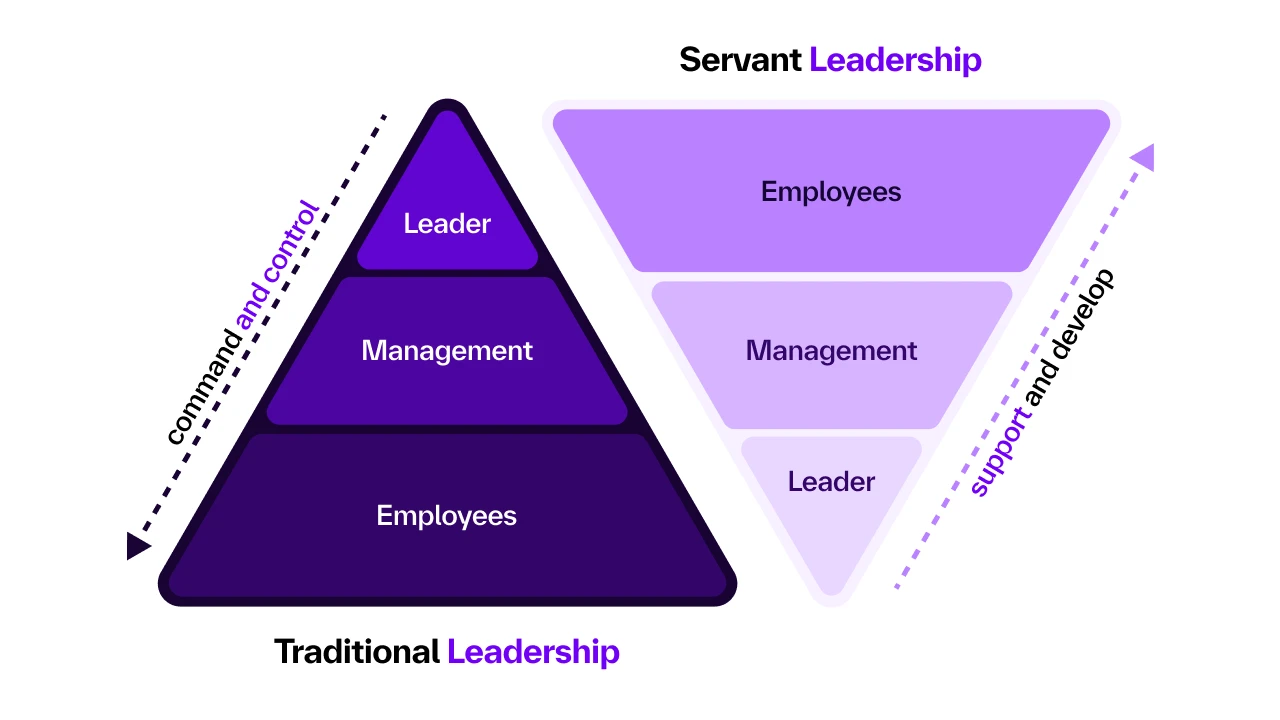The saying "first come, first serve" often promotes selfish thinking. This contrasts with the servant leadership approach. At a time when collaboration, innovation and social responsibility are becoming increasingly important in companies, servant leadership offers an answer to the changing world of work. Read on to find out where empathic, value-oriented and selfless leadership originated, how it works and what opportunities servant leadership offers.
Definition: What is servant leadership?
Servant leadership is a special leadership model that Robert K. Greenleaf first published in 1970 in his essay "The Servant As Leader". In servant leadership, the name says it all - the well-being of employees has top priority. With this approach, the manager shares their decision-making power within the team and focuses on the needs of the employees. The aim is to promote individual skills and create a trusting working environment. In the long term, this leads to greater satisfaction and productivity. A servant leader knows how to take a step back in their own position.
"The servant-leader is servant first ...
It begins with the natural feeling that one wants to serve, to serve first."
Robert K. Greenleaf
Servant leadership reverses the traditional understanding of roles: Instead of demanding what employees have to do, managers focus on how they can empower their teams to act on their own responsibility. This approach emphasizes that effective leadership should be based primarily on emotional intelligence.
10 characteristics of a servant leader
The principles of the leadership model presuppose certain character traits in a servant leader. The focus is on the team with its diverse personalities and needs. Servant leaders should motivate their team and actively involve them in decisions. Only if a suitable working environment is created can the members develop their full potential.
"The words servant and leader are usually thought of as being opposites."
Larry C. Spearce
Although "servant leadership" sounds contradictory at first, Larry C. Spears, Chairman of the Center for Servant Leadership, has identified ten essential characteristics of a servant leader. These include:
- Listen
- Empathy
- Healing (in the sense of emotional support)
- Self-confidence
- Persuasiveness
- Foresight
- Stewardship
- Commitment to growth
- Building community
- Community awareness
A manager who embodies these qualities has a good chance of success. Servant leaders rely on comprehensive trust in their employees. Instead of assigning traditional tasks, they motivate their team with inspiring ideas and visions.
A comparison of leadership styles: classic leadership style vs. servant leadership

Traditional leadership styles such as the authoritarian, cooperative or laissez-faire style often assign roles rigidly. Newer approaches such as servant leadership, on the other hand, take into account the individuality of people, projects and processes. The difference to the authoritarian leadership style is particularly great. Here, a dominant authority figure and a supportive motivator face each other.
The approaches differ significantly in the following five criteria:
| Criteria | Authoritarian management style | Servant Leadership |
| Focus | Authority and control in a hierarchical working environment | Employees' needs, development and sense of belonging in a supportive environment |
| Authority | Centralized power structure | Democratic and collaborative approach, power and decision-making responsibilities are shared |
| Communication | Top-down communication often leads to employees feeling undervalued | Open and transparent communication, strengthens trust and appreciation within the team |
| Decision making | Decisions are usually made single-handedly | Consensus building and cooperative decision-making, contributions and perspectives of team members are valued and taken into account |
| Development | Selected persons or the leader himself | Supports the growth of all team members |
Advantages of servant leadership for employees and companies
A servant leader creates a collaborative environment in which employees can work in a self-organized and autonomous manner. Through regular feedback and support, servant leaders encourage the exchange of ideas and strengthen innovation and creativity. Servant leadership specifically emphasizes employee satisfaction by recognizing what makes each individual unique. It enables employees to actively contribute and develop their individual talents and potential.
They create spaces for appreciation in which team members can develop and realize their potential. From this appreciative approach, employees develop a deep emotional bond with the company and identify authentically with its goals and values. The result is a noticeable transformation: employee turnover drops significantly - at the same time, a robust, dynamic corporate culture is created that is based on mutual trust, respect and shared development.
Leadership
Management development program
Send managers on a development journey: In our development program, your managers learn a differentiated leadership approach. They develop a new, holistic understanding of leadership. This facilitates the transformation towards a modern leadership culture in your company.
Management development program
Examples of successful servant leaders in business
Servant leadership is not just a theory, it is practiced by some of the most successful leaders in the technology industry. One outstanding example is Tim Cook, the CEO of Apple. He is known for his calm and level-headed character and places great value on teamwork and inclusive decision-making. For him, active listening is the key to success; he constantly seeks feedback from his employees in order to identify potential for improvement. He is not afraid to ask his employees questions to find out whether they really know their tasks well.
Another example is Howard Schultz, the former CEO of Starbucks. At his farewell, he emphasized the importance of his leadership style and said: "Everyone in the company has the opportunity to make a contribution. Everyone has a responsibility to take it personally."
These managers are impressive examples of what servant leadership looks like in practice: They prioritize the needs of their employees, creating a culture of collaboration and innovation.
Practical implementation in day-to-day work
Servant leadership is particularly suitable for organizations that are struggling with problems such as a lack of employee retention or a lack of innovation. This approach is widespread in the technology sector, especially in scrum teams. Here, the scrum master often takes on the role of servant leader. They act as an interface to the organization and continuously improve the working environment so that the team can work more efficiently. Without direct decision-making authority, they act as a moderator and support the team in making their own decisions and introducing changes.
However, this style does not suit all areas. It is less suitable for professions such as the police or fire department, where quick decisions and clear hierarchies are important. Creative industries, on the other hand, benefit particularly from servant leadership - provided that the manager and employees accept the leadership model and implement it correctly.
Challenges and limitations of the servant leadership concept
Despite its many advantages, servant leadership also brings with it some challenges:
- Different work preferences: Not all employees feel comfortable in self-organized structures. Some people prefer clear instructions and stronger leadership. For them, the transition to a servant leadership model can cause uncertainty and stress.
- Difficult transformation process: The change from a traditional, hierarchical management style to servant leadership is often complex and time-consuming. Both managers and employees have to develop new skills and get rid of old habits. This process requires patience, continuous learning and possibly external support.
- Risk of delayed error detection: As servant leadership relies on trust and personal responsibility, the reduced control could lead to errors or problems being detected later. This requires a well-functioning feedback system and an open error culture within the company.
- Danger of overemphasizing employee needs: Too much focus on the individual needs of employees can lead to overarching company goals being lost sight of. Servant leaders must find a balance between employee orientation and determination.
- Challenge in crisis situations: In emergencies or under intense time pressure, the consensus-oriented approach of servant leadership can be too slow. In such situations, quick, direct decisions are required.
- Misunderstandings about the leadership role: The term servant leadership can be misunderstood. Some might assume that the leader gives up their authority completely, which is not the case. Rather, it is about a reorientation of the leadership role.
Transformation step by step
Servant leadership is not a miracle solution that is activated at the touch of a button.It is a journey - dynamic, challenging and full of learning curves. It takes courage and perseverance. Companies should introduce the approach gradually, evaluate it regularly and adapt it if necessary.
7 tips for developing servant leadership skills
- Strengthen self-reflection: Keep a leadership diary to reflect on your actions and their impact on the team. Take part in regular mindfulness exercises to sharpen your self-awareness.
- Practice active listening: Practice the "three-minute rule" to listen carefully to your employees and take their feedback seriously. Devote your attention to the other person for a full three minutes without interrupting them. Read body language, tone and rhythm of voice to filter out the core of the message.
- Develop empathy: Put yourself in your employees' shoes - understand why they think the way they do. Ask further questions that lead to a better understanding on both sides.
- Expand your coaching skills: Despite a busy schedule, find time to integrate small coaching moments into everyday situations. This will provide you with regular situations in which you can practise, consolidate and improve your skills.
- Build trust and team spirit: Create transparency through regular team meetings and delegate important tasks to your team. Organize team-building activities and introduce a mentoring program.
- Establish a culture of continuous learning and feedback: Create an open and respectful atmosphere in your team. Your employees will find it easier to give and accept honest and constructive feedback. Also make your team's willingness to learn a matter close to their hearts. As a manager, you should actively demand and exemplify this willingness.
- Apply agile methods and exemplify ethical behavior: Learn agile frameworks such as Scrum and reflect together with your team on a code of conduct that reflects the values of servant leadership.




